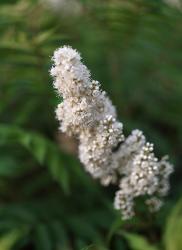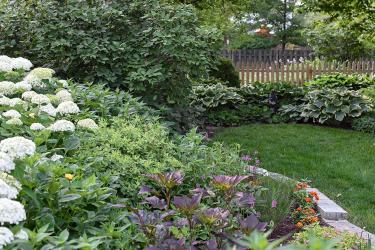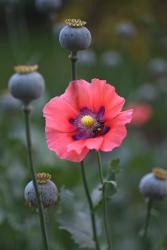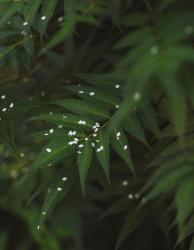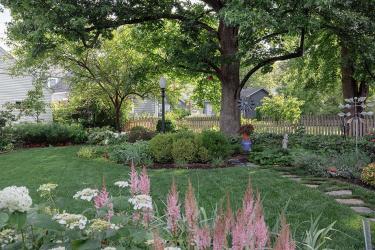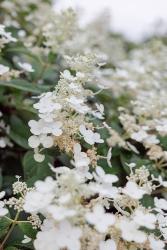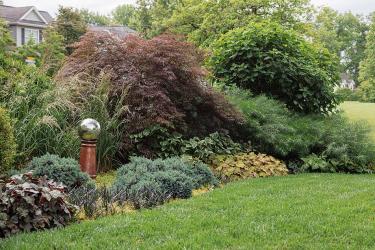When Fred Ortlip worked nights as a copy editor for the St. Louis Post-Dispatch, he used his daytime hours for a round or two of golf each week with his Post colleagues. As he watched his ball sail down the fairway or eyeballed the correct line of a putt, he also focused on something having nothing to do with the sport. “I admired a lot of the landscaping around the golf courses,” he recalls. In the late 1990s, when he and his wife Rory had some money left over from an insurance check to repair hail damage to their Kirkwood home, they decided to use it to enhance their own landscape. “Everyone likes to look at nice landscaping,” he reasoned. “I wondered, ‘What kind of potential do we have here?’”
Living just a few blocks from Sugar Creek Gardens nursery center, he decided to take advantage of their free design consultation service to enhance a shady front walk where the couple, who moved into their home in 1979, had always had trouble growing grass. “I asked them to create a plan.” The result was a combination of vigorous, purple-flowering cranesbill, hardy geranium and dainty, triangle-leaved epimedium, also known as bishop’s hat or barrenwort. Both plants are low maintenance, have a mounding habit and interesting foliage that offers fall color. So successful was that combination, it still lines the front walk more than 25 years later, even though there is now more sun along the walkway.
“What they put in looked really nice,” Fred says. Seeing that transformation fueled his interest in landscaping, plus a switch to the day shift at the Post cut back on his golf outings. “The golf was not cheap,” he says with a laugh. “I decided I could put that money into gardening and have a little more success than I did on the golf course.”
In addition, with his two sons now grown and weekends freed up from kids’ activities, “I was at a jumping off point to find a hobby that was really enjoyable,” he adds. Where his yard was concerned, “I didn’t have a grand plan,” Fred continues. “I don’t think most people have a grand plan. You do it piecemeal. I went from the front sidewalk to the back yard and the area around the screened porch. I just kept nibbling away.” A gardening “aha” moment came when he planted underneath a sweetgum tree, a group of hostas a neighbor had given him. Because grass wouldn’t grow in the tree’s heavy shade, Fred and his wife had covered the bare ground with mulch each spring for the past 20 years. He witnessed how the hostas flourished in the naturally amended soil.
The more he gardened, the more he wanted to know. He read books and articles on gardening “but I really struggled to get stuff to grow and look right. You buy one perennial and you put it in the ground and then you buy another perennial and you put it in the ground but then you have this mishmash of perennials that don’t look very good.”
In 2008, Fred decided to become even more serious about his hobby by taking the Master Gardener course offered by the University of Missouri Extension Service through the Missouri Botanical Garden. When he completed the course, he went to his friends at Sugar Creek, where he bought his plants, and asked for a part-time job on weekends. “I was still working at the Post and sometimes doing shifts both Saturday and Sunday at Sugar Creek and volunteering on Sunday mornings at the Missouri Botanical Garden." By 2010, he had amassed enough knowledge to do gardening consultations for Sugar Creek, helping other gardeners in the same way he had been helped in the late 1990s. “Looking back, I don’t know how I did all that,” he says with a laugh.
Fred retired from the Post-Dispatch in 2015 but not from gardening. He took on more hours at Sugar Creek and devoted additional time to his own yard. Throughout the years, his landscaping “nibbles” have skillfully transformed his yard into a bountiful banquet of beautiful plants.
Tiny ‘Anna’s Magic Ball’ arborvitae, ‘Candy Corn’ spirea and variety of soft grasses now augment the original cranesbill and epimedium along the front walk. The colorful leaves of heuchera or coral bells and feathery stems of blue star amsonia add accents to a front border anchored with hydrangeas, boxwoods, crepe myrtle and feather reed grass. Bronze-leaved begonias with bright red-orange flowers provide continual pops of color and tie the beds together.
Around the back, Fred created beds circling the perimeter of the yard and flagstone pathways to get from one area to another. Under the sweetgum tree, boxwoods, hydrangeas, variegated Solomon’s seal and chartreuse-leaved ‘Sun King’ aralia have joined the original hostas.
Poppies, purple-leaved sedum, hydrangeas and grasses now surround the screened porch. As he planted and tended his landscaping feast, Fred used his own yard as a test kitchen for a wide variety of shrubs, perennials and annuals. Plants that worked well for him, he felt good about recommending to clients when he went out on consultations.
Through the years, he has developed some favorites that are reliable and can enhance many different landscapes like Allium ‘Millenium.’ Even though the folks who named this cultivar misspelled millennium, which offends Fred’s sensibilities as a copy editor, he considers the plant itself a winner. Standing between 15-20 inches tall, it produces fragrant, ball-like purple flowers on strong stems from mid through late summer and after that, attractive seed heads remain. It grows in full sun to part shade and can tolerate a wide variety of soils.
Spirea ‘Candy Corn’ candy-apple red foliage emerges in spring, turning to bright yellow as the season progresses. New growth tips the branches with bright, red-orange leaves (hence the name), and if that weren’t enough, the plant produces magenta flowers over a long season. The compact size of between 18-24 inches tall and 30 inches wide makes it a nice option in place of annuals where gardeners want season-long color.
Hubricht’s Bluestar Amsonia, a standout for its feathery, thread-like foliage that sways in the slightest breeze, produces pale-blue, star-shaped blossoms in spring and turns vibrant yellow in fall. Growing 2-3 feet tall, it can be cut back about 6 inches after flowering if a homeowner wants a more mounded shape. It will thrive in sun to part shade and tolerate moist conditions. Amsonia ‘String Theory’ is a new cultivar that tops out at 22 inches and works well in smaller spaces.
Oakleaf Hydrangea, tried and true, are easy to grow in sun to part shade and produce showy white blossoms in early summer that last for weeks before fading to pink and then brown. In fall, the foliage transforms to burgundy red, and the peeling bark of the mature stems makes the shrub attractive even in winter. A wide variety of cultivars ensures the shrub is available in multiple shapes and sizes.
Turtlehead, named for the shape of the hooded, snapdragon-like flowers which resemble a turtle’s head, is a favorite of Fred's for its long bloom season from “August to frost” and the ability to “just fill up a space” in the garden. The blossoms can be pink, rose or white and the plant will grow 2-3 feet tall in both sun and shade. The height can be controlled by pinching stem ends back in spring. Although native to swampy areas, turtlehead can tolerate brief dry spells.
Fred’s knowledge of a wide variety of plants and how to use them in the landscape makes gardening almost a second career. What has immersed him so heavily in this new avocation? “I’ve always had this need to be creative,” he explains. “I’m a journalist so I can write, and I’ve always been interested in design. Gardening opens up another door to being creative. It is not always easy. You make mistakes. Plants don’t always do what you want them to. The digging and the planting is hard work, but there is enjoyment in creating something that looks really nice.”


